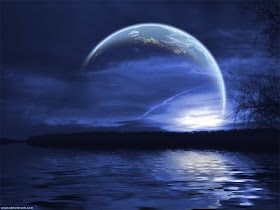For the first time in almost 20 years, a bright
"blue moon"
will grace New Year's Eve celebrations worldwide.If the skies are clear, revelers looking up at midnight will get an eyeful of the second full moon of the month—commonly called a blue moon.
One of the most dramatic sights in the night sky—and inspiration for poets, artists, and lovers for millennia—full moons captivate us like nothing else.
The last time a blue moon appeared on New Year's Eve was in 1990, and it won't happen again until 2028. A blue moon isn't actually blue—as commonly defined, the name reflects the relative rarity of two full moons in a month and is linked to the saying "once in a blue moon."
"Full moons around winter solstice rise their highest for the entire year"
In any location, the high, silvery orb will seem like a floodlight cast on the landscape
For millennia, humans have used the movement of the moon to keep track of the passing year and set schedules for hunting, planting, and harvesting. Ancient cultures the world over have given these full moons names based on the behavior of the plants, animals, or weather during that month.
January: Wolf Moon
Native Americans and medieval Europeans named January's full moon after the howling of hungry wolves lamenting the midwinter paucity of food. Other names for this month's full moon include old moon and ice moon.
February: Snow Moon
The typically cold, snowy weather of February in North America earned its full moon the name snow moon. Other common names include storm moon and hunger moon.
March: Worm Moon
Native Americans called this last full moon of winter the worm moon after the worm trails that would appear in the newly thawed ground. Other names include chaste moon, death moon, crust moon (a reference to snow that would become crusty as it thawed during the day and froze at night), and sap moon, after the tapping of the maple trees.
April: Pink Moon
Northern Native Americans call April's full moon the pink moon after a species of early blooming wildflower. In other cultures, this moon is called the sprouting grass moon, the egg moon, and the fish moon.
May: Flower Moon
May's abundant blooms give its full moon the name flower moon in many cultures. Other names include the hare moon, the corn planting moon, and the milk moon.
June: Strawberry Moon
In North America, the harvesting of strawberries in June gives that month's full moon its name. Europeans have dubbed it the rose moon, while other cultures named it the hot moon for the beginning of the summer heat.
July: Buck Moon
Male deer, which shed their antlers every year, begin to regrow them in July, hence the Native American name for July's full moon. Other names include thunder moon, for the month's many summer storms, and hay moon, after the July hay harvest.
August: Sturgeon Moon
North American fishing tribes called August's full moon the sturgeon moon since the species was abundant during this month. It's also been called the green corn moon, the grain moon, and the red moon for the reddish hue it often takes on in the summer haze.
September: Harvest Moon
The most familiar named moon, September's harvest moon refers to the time of year after the autumn equinox when crops are gathered. It also refers to the moon's particularly bright appearance and early rise, which lets farmers continue harvesting into the night. Other names include the corn moon and the barley moon.
October: Hunter's Moon
The first moon after the harvest moon is the hunter's moon, so named as the preferred month to hunt summer-fattened deer and fox unable to hide in now bare fields. Like the harvest moon, the hunter's moon is also particularly bright and long in the sky, giving hunters the opportunity to stalk prey at night. Other names include the travel moon and the dying grass moon.
November: Beaver Moon
There is disagreement over the origin of November's beaver moon name. Some say it comes from Native Americans setting beaver traps during this month, while others say the name comes from the heavy activity of beavers building their winter dams. Another name is the frost moon.
December: Cold Moon
The coming of winter earned December's full moon the name cold moon. Other names include the long night moon and the oak moon.
The Blue Moon
Each year, the moon completes its final cycle about 11 days before the Earth finishes its orbit around the sun. These days add up, and every two and a half years or so, there is an extra full moon, called a blue moon.
The origin of the term is uncertain, and its precise definition has changed over the years. The term is commonly used today to describe the second full moon of a calendar month, but it was originally the name given to the third full moon of a season containing four full moons.
Have a magical New Year
Love and the very brightest lightTraceyanne
)O(
 Rachel
Rachel A tiny Fairy Swing sits underneath a magically lit flowered branch in an enchanted crystal and moss covered grove, just waiting for a fairy to come a long and play...
A tiny Fairy Swing sits underneath a magically lit flowered branch in an enchanted crystal and moss covered grove, just waiting for a fairy to come a long and play... Two sets of lights illuminate this beautiful fantasy scene.
Two sets of lights illuminate this beautiful fantasy scene. Standing 16 inches high, 7 inches wide ( at it's widest point ) and about 4 1/2 inches deep.
Standing 16 inches high, 7 inches wide ( at it's widest point ) and about 4 1/2 inches deep.
